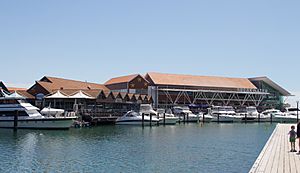Hillarys, Western Australia facts for kids
Quick facts for kids HillarysPerth, Western Australia |
|||||||||||||||
|---|---|---|---|---|---|---|---|---|---|---|---|---|---|---|---|
 |
|||||||||||||||
| Established | 1970s. | ||||||||||||||
| Postcode(s) | 6025 | ||||||||||||||
| Area | 6.3 km2 (2.4 sq mi) | ||||||||||||||
| Location | 21 km (13 mi) from Perth City | ||||||||||||||
| LGA(s) | City of Joondalup | ||||||||||||||
| State electorate(s) | Hillarys | ||||||||||||||
| Federal Division(s) | Moore | ||||||||||||||
|
|||||||||||||||
Hillarys is a coastal suburb located north of Perth, the capital city of Western Australia. It's part of the City of Joondalup area. Hillarys is about 21 kilometers (13 miles) northwest of Perth's city center. It's known for its beautiful coastline and the popular Hillarys Boat Harbour.
Contents
History of Hillarys
How Hillarys Got Its Name
Hillarys is named after an early settler named Bertram John Hillary. He came to the area in the 1930s during the Great Depression, a time when many people struggled to find work. Bertram, who had been injured during World War I, fished for a living with his brother Harry. He built a small boat shed on the beach in 1930. Later, he made it bigger so his family, including his wife and four children, could live there. For many years, the Hillary family were the only people living in what is now Hillarys. The closest shop was 5 kilometers (3 miles) away!
Development of the Area
During World War II, the Australian Army used the area and even called it "Hillary's Beach" on their maps. Sadly, Bertram Hillary passed away in 1957. A big storm in 1964 destroyed his shack and 14 other nearby buildings.
In the 1960s, plans were made to develop the coastal area. A major Catholic school, Sacred Heart College, moved to the region in 1967, and a road was built to Whitford Beach.
The local council and a bank started planning a town center, which later became Westfield Whitford City, a large shopping mall. The suburb of Hillarys was officially named in 1971. Many streets in the new area were named after famous Australian explorers and pioneers. The Whitford City Shopping Centre officially opened in 1978.
Hillarys Boat Harbour
In the 1980s, the government decided to build Hillarys Boat Harbour. This was the first big marina (a place for boats) in the northern Perth area. It was built to help Australia prepare for the 1987 America's Cup, a famous sailing race. The shops and restaurants at the harbour, called Sorrento Quay, opened in 1987 and 1988.
Also, in 1987, the Marmion Marine Park was created. This special park protects marine animals along the coast from Burns Beach to Trigg. Hillarys Boat Harbour became a great starting point for exploring this marine park. The shopping center and marina helped Hillarys grow a lot, and by the mid-1990s, most of the suburb was fully developed.
Geography and People
Hillarys is bordered by Hepburn Avenue to the south, Marmion Avenue to the east, and Whitfords Avenue to the north. The ocean is to the west.
Hillarys is a popular place to live. Many families enjoy its location by the ocean, its closeness to schools, and the fun Hillarys Boat Harbour.
Things to Do in Hillarys
Hillarys is mainly a residential area, meaning it's mostly homes. For shopping and services, people go to Westfield Whitford City, a big shopping center, or the smaller Hillarys Shopping Centre.
Schools in Hillarys
Hillarys has several schools, including Hillarys Primary School and St. Mark's Anglican Community School. St. Mark's is a private school for students from kindergarten to Year 12.
Parks and Beaches
You can find many parks and walking paths in Hillarys. There are also picnic spots in a coastal park just north of Hillarys Boat Harbour. The beaches in Hillarys can be a bit tricky to reach because of large sand dunes. People often go to Whitford Beach to the north or Sorrento Beach to the south for easier beach access.
Marmion Marine Park
Off the coast of Hillarys is the Marmion Marine Park. This protected area is home to many different kinds of marine animals, like fish, dolphins, and even whales. It's a great place for snorkeling, diving, and learning about ocean life.
Tourism and Fun
Hillarys Boat Harbour is a major attraction. It has the Sorrento Quay retail area, which is full of shops and places to eat. You can also visit the Aquarium of Western Australia (AQWA) here, where you can see amazing marine creatures up close.
From the harbour, you can take helicopter rides or catch a ferry. During certain times of the year, you can go on whale watching cruises to see whales migrating. Ferries also travel from Hillarys to Rottnest Island, a popular island known for its quokkas and beautiful beaches.
Economy
Hillarys is involved in the aquaculture industry, which is about farming seafood. There's a special facility here called a hatchery. In 2020, this hatchery grew baby shellfish called "spat" for black-lip rock oysters. These spat were then moved to trial sites off the coast near Karratha and Derby. This was the first time these oysters were grown commercially in Western Australia. This new industry is expected to create jobs and help the economy, especially for Indigenous people in the Pilbara region.
Education
Hillarys is served by Hillarys Primary School, which opened in 1973. The suburb also has St Mark's Anglican Community School, a private school that opened in 1986. For older students, Hillarys is part of the Duncraig Senior High School area.
Transport
Hillarys is connected by Transperth buses. These buses, like routes 441 and 442, travel between Whitfords and Warwick railway stations. These stations are on the Joondalup train line, which can take you to Perth city and other suburbs.
Images for kids





